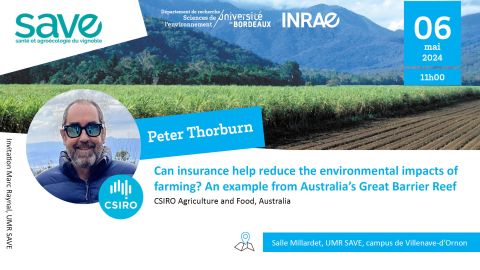Abstract
Can insurance help reduce the environmental impacts of farming? An example from Australia’s Great Barrier Reef
Peter Thorburn, Jody Biggs, Tony Webster, Larelle McMillan
CSIRO Agriculture and Food, Australia
Discharge of dissolved inorganic nitrogen (DIN) from sugarcane farms is a major threat to the Great Barrier Reef (GBR), a World Heritage listed ecosystem with an annual value of AUD6.4B to the Australian economy. An important pathway to reducing these impacts is to have farmers optimise N fertiliser applications to their crops.
For sugarcane farmers, managing N fertiliser is an exercise in risk management, i.e. applying high rates of N to minimising the risk of low yields. We asked: Could insurance provide an alternative risk management tool and facilitate reduced N fertiliser applications? In answer to that question we developed an original insurance concept to manage the risk to yields, and reduce the financial risk associated with optimising N applications. This required determining, amongst other things, whether the insurance was structured as an indemnity or parametric product, the spatial and temporal scale at which it was offered, and whether there was farmer appetite for such a product. For the latter problem, we developed a prototype commercial product and had sugarcane farmers “buy” mock insurance. Feedback from the farmers about the concept was positive. Biophysical and financial outcomes of these “purchases” were evaluated over 70 years. The average outcome was farmers being financially better off by >AUD8/ha because claims payouts from the insurance policies combined with the savings in fertiliser costs were greater than insurance premiums. Insurance broker’s fees and insurer’s “underwriting profit” were both approximately AUD 6/ha. If these policies were purchased over 40% of the study region there would be approximately 100 t/year less DIN discharged to the GBR from those catchments. Achieving this outcome through government grants and incentives would cost approximately AUD27M/year.
This innovative insurance concept can thus provide financial benefits for farmers, insurance companies and the public, as well as environmental benefits for the GBR. The product was offered commercially in the 2022 cropping season, and is available again in 2023. The concept can be generalised to other crops, other environmental issues and to simpler problems such as drought-induced yields.
Suivre le séminaire en ligne
Ce séminaire est organisé in vivo par l'UMR SAVE. Il se déroulera dans la salle Millardet de l'unité, sur le site INRAE de la Grande Ferrade (33140 Villenave d'Ornon).
Pour celles et ceux qui ne pourraient se rendre sur place, une diffusion en ligne sera mise en place et accessible à partir de 11h00 en cliquant sur le lien suivant.
Peter Thorburn | Can insurance help reduce the environmental impacts of farming?
Dernière mise à jour :


